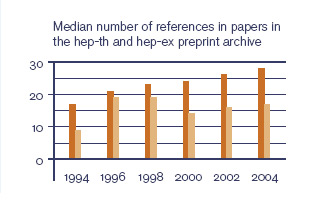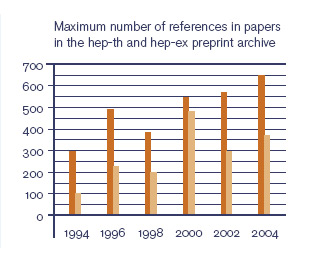On the shoulders of how many giants?
Scientists since the time of Sir Isaac Newton (and before) have built their work on the work of those who preceded them. Newton famously described this by saying, “If I have been able to see farther, it was only because I stood on the shoulders of giants.” (Letter to Robert Hooke, February 5, 1675. Source: wikiquote.org)
|
Modern-day physicists may not have Newton’s turn of phrase, but they still give credit where credit is due, by referencing the works that they have used to formulate their own research.
Often we think of these citations as suggesting somehow the quality, utility, or relevance of the paper being referenced. But what about the other side of the equation: the paper making the references? How many shoulders does one stand upon; that is, how many papers does one reference when writing a new paper?
The answer depends upon the field of research. Shown in the charts are the numbers of references for two different fields: mathematical particle theory (hep-th) and particle experiment (hep-ex).
In 2004, the median numbers of references given in a paper were 29 (theory) and 17 (experiment). The maximums were 650 (theory) and 369 (experiment). Such long lists of references are quite rare and are generally review papers rather than original research.
The theoretical fields list noticeably more references per paper than the experimental ones. This is not surprising given that experimentalists tend to write fewer papers (886 versus 3357 in 2004), and thus the literature is a smaller set. Perhaps more importantly, experimental papers generally describe the results and setup of an experiment built and run by the authors. While these experimental techniques rely upon other scientists, and the motivation also derives from other papers, they represent less direct connections than the theorists work with. Theoretical literature tends to carry on a conversation style of revising, extending, and sometimes subtracting from, previous work.
Curiously, the number of references per paper has increased a little over the years. This may reflect the electronic advances that have increased the ease of communication and the ease of citing. It may also be due to the increased accuracy of databases such as spires.
Travis Brooks, SLAC
Click here to download the pdf version of this article.









